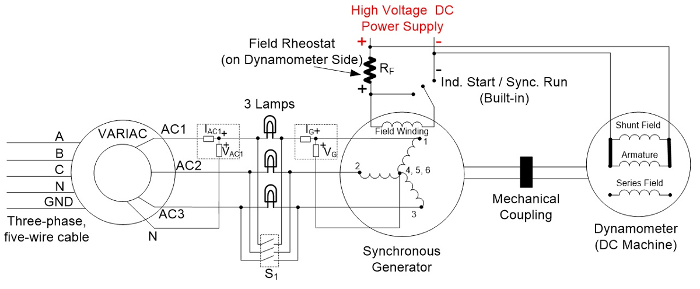AC Synchronous Machine Synchronization
Source: Ali Bazzi, Department of Electrical Engineering, University of Connecticut, Storrs, CT.
Three-phase wound-rotor synchronous generators are the main source of electrical power worldwide. They require a prime mover and an exciter in order to generate power. The prime mover can be a turbine spun by fluid (gas or liquid), thus the sources of the fluid can be water running off a dam through a long nozzle, steam from water evaporated using burned coal, etc. Most power plants including coal, nuclear, natural gas, fuel oil, and others utilize synchronous generators.
The objective of this experiment is to understand the concepts of adjusting the voltage and frequency outputs of a three-phase synchronous generator, followed by synchronizing it with the grid. The effects of field current and speed variations on the generator output power are also demonstrated.
1. Prime-Mover Initialization
The prime-mover in this experiment is the dynamometer, which operates as a motor that spins the generator rotor (field).
- Make sure the three-phase disconnect switch, synchronous motor switch, and DC motor switch are all off.
- Check that the VARIAC is at 0%.
- Wire the VARIAC to the three-phase outlet and connect the setup shown in Fig. 1.
- Use the three-phase switch on the synchronous machine side as "S1."
The desired speed of the prime-mover is set at 1,800 RPM since the synchronous machine has four poles (P) and operates at a frequency f= 60 Hz, thus synchronous speed is 120f/P= 1,800 RPM.
When synchronizing the synchronous machine (generator) to the grid, the machine's prime-mover provides rotation, but a magnetic field on the machine's rotor should be provided. This is achieved using
Synchronous generators are the backbone of electricity generation in power plants worldwide. Synchronizing a generator to the grid has become standard practice and is typically automated by matching the phase sequences, voltage magnitudes, and frequencies of the generator to the grid. Voltage control using the rotor magnetic field is achieved using "exciters," while frequency control is achieved using the speed control of a turbine or prime-mover, providing rotation using steam, wind, water, or other fluids. Frequency co
Saltar a...
Vídeos de esta colección:

Now Playing
AC Synchronous Machine Synchronization
Electrical Engineering
21.5K Vistas

Precauciones de seguridad eléctrica y equipamiento
Electrical Engineering
144.4K Vistas

Caracterización de componentes magnéticos
Electrical Engineering
14.9K Vistas

Introducción a la placa de polos de potencia
Electrical Engineering
12.4K Vistas

Convertidor DC/DC
Electrical Engineering
56.5K Vistas

Convertidor Buck DC/DC
Electrical Engineering
21.0K Vistas

Convertidor de retroceso
Electrical Engineering
13.2K Vistas

Transformadores monofásicos
Electrical Engineering
20.1K Vistas

Rectificadores monofásicos
Electrical Engineering
23.3K Vistas

Rectificador de tiristores
Electrical Engineering
17.4K Vistas

Inversor monofásico
Electrical Engineering
17.9K Vistas

Motores de corriente continua
Electrical Engineering
23.3K Vistas

Caracterización de motores de inducción de CA
Electrical Engineering
11.6K Vistas

Máquina de inducción de CA alimentada por VFD
Electrical Engineering
6.9K Vistas

Caracterización de máquinas sincrónicas de CA
Electrical Engineering
14.2K Vistas
ACERCA DE JoVE
Copyright © 2025 MyJoVE Corporation. Todos los derechos reservados
